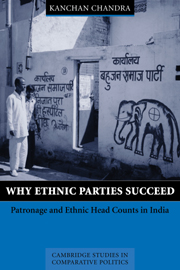Book contents
- Frontmatter
- Dedication
- Contents
- List of Maps, Figures, and Tables
- List of Abbreviations
- A Note on Terminology
- Acknowledgments
- 1 Introduction
- Part I Theory
- Part II Data
- Appendix A Elite Interviews
- Appendix B Ethnographies of Election Campaigns
- Appendix C Content Analysis
- Appendix D Description of Survey Data
- Appendix E Description of the Ecological Inference (EI) Method
- Appendix F Method Used to Estimate Ethnic Voting Patterns
- Bibliography
- Index
- Miscellaneous Endmatter
Appendix F - Method Used to Estimate Ethnic Voting Patterns
Published online by Cambridge University Press: 19 October 2017
- Frontmatter
- Dedication
- Contents
- List of Maps, Figures, and Tables
- List of Abbreviations
- A Note on Terminology
- Acknowledgments
- 1 Introduction
- Part I Theory
- Part II Data
- Appendix A Elite Interviews
- Appendix B Ethnographies of Election Campaigns
- Appendix C Content Analysis
- Appendix D Description of Survey Data
- Appendix E Description of the Ecological Inference (EI) Method
- Appendix F Method Used to Estimate Ethnic Voting Patterns
- Bibliography
- Index
- Miscellaneous Endmatter
Summary
The estimates for the percentage of Scheduled Castes voting for the BSP, of Hindus voting for the BJP, ofTamils voting for the DMK, and of Jharkhandis voting for the JMM are arrived at in the following way: I assume that (1) all the votes of the ethnic party in question came from members of its target ethnic category, (2) the percentage of the target ethnic category in the electorate is the same as the percentage in the population, and (3) turnout rates across ethnic categories are equal. Based on these three assumptions, I arrive at estimates of the percentage of the ethnic category supporting the ethnic party in question by calculating the percentage of the vote obtained by the ethnic party as a proportion of the percentage of the target ethnic category in the population. The data on which these estimates are based are summarized in the accompanying tables.
I detail here how I use this method for calculating Scheduled Caste voting patterns for the BSP. In the absence of survey data on individuallevel voting patterns, or of sufficiently detailed data to permit an EI analysis, this is the simplest and most transparent way of assessing the degree of support for an ethnic party among its target ethnic group. The possible biases that these assumptions introduce are identified below. If we know that these assumptions are violated in particular cases, we can adjust them accordingly, or at least estimate the direction of bias.
In estimating the percentage of Scheduled Castes voting for the BSP across states, I assume that (1) all of the BSP's votes in each state come from Scheduled Castes, (2) the percentage of Scheduled Castes in the electorate is identical to that in the population, and (3) the turnout rates of Scheduled Castes and the rest of the population are equal. Based on these assumptions, I arrive at the estimates by calculating the average vote for the BSP across the five parliamentary elections (1984, 1989, 1991, 1996, and 1998) as a proportion of the overall Scheduled Caste population in the state. For example, if the BSP obtains an average of 10 percent of the vote in a state in which 20 percent of the population is from the Scheduled Castes, I would estimate that 50 percent of the Scheduled Castes in the state, on average, supported the BSP.
- Type
- Chapter
- Information
- Why Ethnic Parties SucceedPatronage and Ethnic Head Counts in India, pp. 310 - 316Publisher: Cambridge University PressPrint publication year: 2004



